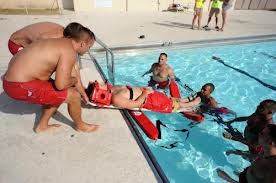Today we had our first written test. We literally walked into the class and started the test. I thought it was pretty easy but there were definitely some questions that could go either way. Overall I was pretty sure that I had at least passed.
After a grueling wait, we finally got our tests back and I found out that I had missed 6 questions. I was happy that I had passed the test but I was also kind of disappointed that I didn't do better. The class is pass fail, so grades don't really matter but I'm kind of a perfectionist and I like to do really well on tests.
Anyways, after finishing our tests we started learning about spinals. Spinal injuries are some of the most dangerous injuries that lifeguards have to deal with. If someone injures their neck/spine it is very important not to move them to prevent paralysis. This makes it difficult to remove a suspected spinal victim from the pool.
Did you know that every year there are approximately 12,000 spinal injuries reported in the United States? 8% of those injures occur from recreational activities like diving into the pool. Spinal injuries are most common in the shallow end of the pool or when someone strikes an object or another person when diving into the pool. Head, neck or back injuries are also common among kids running around the outside of the pool, that slide on the slick surface. Some symptoms of a spinal injury are: heavy external bleeding from the head, neck or back, seizures, blood in the ears or nose, changes in level of consciousness (or LOC), nausea or vomiting, and loss of balance.
There are several methods for rescuing a spinal victim, each depending on the situation.
1) If the victim is in the water and BREATHING, then you should work with another lifeguard to strap them to a backboard and use the head immobilizer device.
2) If the victim is in the water but NOT BREATHING, you should use a method such as the two-person-removal-from-water (one lifeguard supports the body, while the other assists with the backboard) and provide resuscitation.
3) If the victim is on land STANDING, you should secure the victim to a backboard while they remain standing and slowly lower them to the ground.
4) If the victim is on land but NOT STANDING, you should tell the victim to remain in the same position they were found in, until EMS arrives.
head immobilizer device backboard with straps
multiple lifeguard rescue




No comments:
Post a Comment